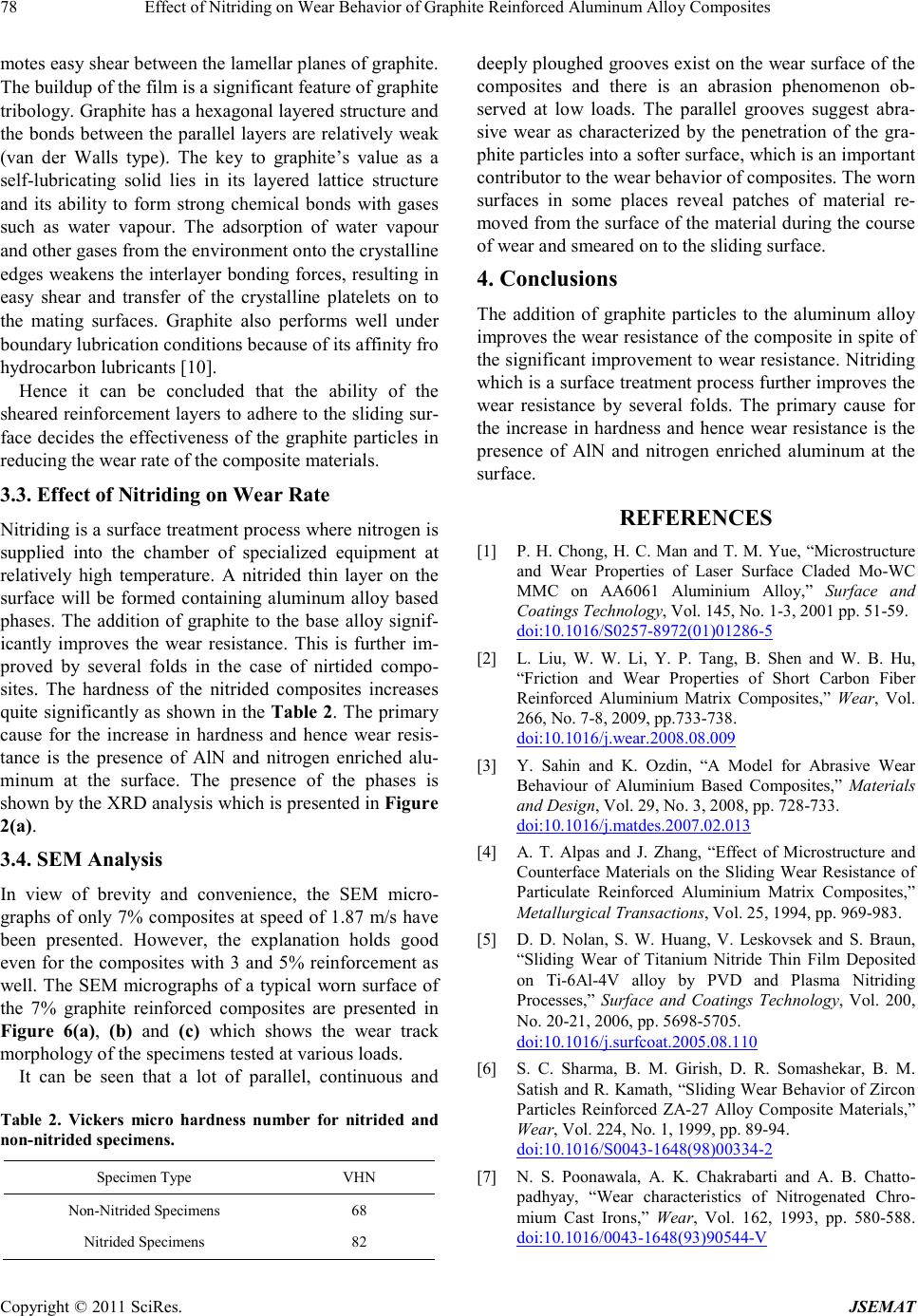
Effect of Nitriding on Wear Behavior of Graphite Reinforced Aluminum Alloy Composites
Copyright © 2011 SciRes. JSEMAT
motes easy shear bet ween the la mellar plane s of graphite.
The buildup of the fi lm i s a significant feature of graphite
tribology. Gra phite has a hexa gona l la yere d str uct ure a nd
the bonds between the parallel layers are relatively weak
(van der Walls type). The key to graphite’s value as a
self-lubricating solid lies in its layered lattice structure
and its ability to form strong chemical bonds with gases
such as water vapour. The adsorption of water vapour
and other gases from the environment ont o the cr ys t alline
edges weakens the interlayer bonding forces, resulting in
easy shear and transfer of the crystalline platelets on to
the mating surfaces. Graphite also performs well under
boundary lubrication conditions because of its affinity fro
hydrocarbon lubricants [10].
Hence it can be concluded that the ability of the
sheared reinforcement layers to adhere to the sliding sur-
face decides the effectiveness of the graphite particles in
reducing the wear rate of the composite materials.
3.3. Effect of Nitriding on Wear Rate
Nitriding is a surface treatment process where nitroge n i s
supplied into the chamber of specialized equipment at
relatively high temperature. A nitrided thin layer on the
surface will be formed containing aluminum alloy based
phases. The addition of graphite to the base alloy signif-
icantly improves the wear resistance. This is further im-
proved by several folds in the case of nirtided compo-
sites. The hardness of the nitrided composites increases
quite significantly as shown in the Ta ble 2. T he primary
cause for the increase in hardness and hence wear resis-
tance is the presence of AlN and nitrogen enriched alu-
minum at the surface. The presence of the phases is
sho wn by the XRD a na l ysi s whic h is p r esented i n Figure
2(a).
3.4. SEM Analysis
In view of brevity and convenience, the SEM micro-
graphs of only 7% composites at speed of 1.87 m/s have
been presented. However, the explanation holds good
even for the composites with 3 and 5% reinforcement as
well. The SEM micrographs of a typical worn surface of
the 7% graphite reinforced composites are presented in
Figure 6(a), (b) and (c) which shows the wear track
morphology of the specimens tested at various loads.
It can be seen that a lot of parallel, continuous and
Table 2. Vickers micro hardness number for nitrided and
non-nitrided specimens.
Specimen Type VHN
Non-Nitrided Specimens 68
Nitrided Specimens 82
deeply ploughed grooves exist on the wear surface of the
composites and there is an abrasion phenomenon ob-
served at low loads. The parallel grooves suggest abra-
sive wear as characterized by the penetration of the gra-
phite particle s into a so fter sur face, which is an i mportant
contributor to the wear behavior of composites. The worn
surfaces in some places reveal patches of material re-
moved from the surface of the material during the c ours e
of wear and smeared on to the sliding surface.
4. Conclusions
The addition of graphite particles to the aluminum alloy
improves the wear resistance of the composite in spite of
the s ignifi cant i mpro vement to wear resi stance. Nitridin g
whi ch is a s urface treatment process further improves the
wear resistance by several folds. The primary cause for
the increase in hardness and hence wear resistance is the
presence of AlN and nitrogen enriched aluminum at the
surface.
REFERENCES
[1] P. H. Chong, H. C. Man and T. M. Yue, “Microstructure
and Wear Properties of Laser Surface Claded Mo-WC
MMC on AA6061 Aluminium Alloy,” Surface and
Coatings Technology, Vol. 145, No. 1-3, 2001 pp. 51-59.
doi:10.1016/S0257-8972(01)01286-5
[2] L. Liu, W. W. Li, Y. P. Tang, B. Shen and W. B. Hu ,
“Friction and Wear Properties of Short Carbon Fiber
Reinforced Aluminium Matrix Composites,” Wear, Vol.
266, No. 7-8, 2009, pp.733-738.
doi:10.1016/j.wear.2008.08.009
[3] Y. Sahin and K. Ozdin, “A Model for Abrasive Wear
Behaviour of Aluminium Based Composites,” Materials
and Design, Vol. 29, No. 3, 2008, pp. 728-733.
doi:10.1016/j.matdes.2007.02.013
[4] A. T. Alpas and J. Zhang, “Effect of Microstructure and
Counterface Materials on the Sliding Wear Resistance of
Particulate Reinforced Aluminium Matrix Composites,”
Metallurgical Transactions, Vol. 25, 1994 , pp. 96 9-983.
[5] D. D. Nolan, S. W. Huang, V. Leskovsek and S. Braun,
“Sliding Wear of Titanium Nitride Thin Film Deposited
on Ti-6Al-4V alloy by PVD and Plasma Nitriding
Processes,” Surface and Coatings Technology, Vol. 200,
No. 20-21, 2006, pp. 5698-5705.
doi:10.1016/j.surfcoat.2005.08.110
[6] S. C. Sharma, B. M. Girish, D. R. Somashekar, B. M.
Satish and R. Kamath, “Sliding Wear Beh avior o f Zircon
Particles Reinforced ZA-27 Alloy Composite Materials,”
Wear, Vol. 224, No. 1, 199 9, pp. 89-94.
doi:10.1016/S0043-1648(98)00334-2
[7] N. S. Poonawala, A. K. Chakrabarti and A. B. Chatto-
padhyay, “Wear characteristics of Nitrogenated Chro-
mium Cast Irons,” Wear, Vol. 162, 1993, pp. 580-588.
doi:10.1016/0043-1648(93)90544-V